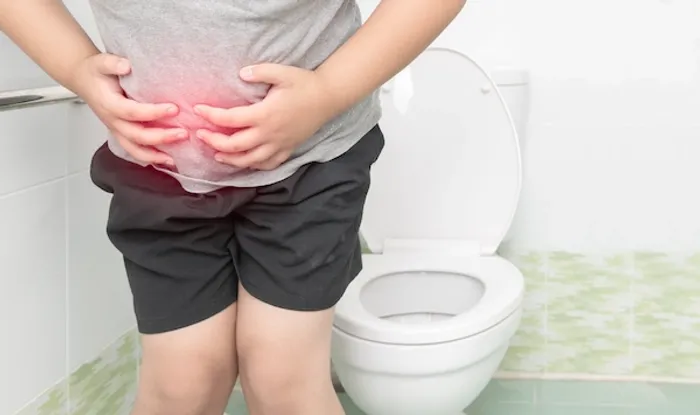Guide to Stop Loose Motions
Know about stopping loose motions, causes, first line of treatment, foods to avoid, and medications to be used when appropriate.


Introduction
If you’re dealing with loose mot (often called “loose motions” or diarrhoea), you want fast, safe relief, and you want to know when it’s okay to manage at home and when it’s time to see a doctor. The good news: most cases of loose motion improve within a couple of days with simple steps like the right fluids, a light diet, and rest. In this doctor-backed guide, you’ll learn exactly how to stop loose mot quickly, which foods help (and which to avoid), which over-the-counter medicines are safe, and the red flags that mean you should get medical care. If symptoms persist beyond two weeks, consult a doctor online with Apollo24|7 for further evaluation. Ready to feel better fast? Let’s start with what “loose mot” really means and the quickest, safest way to settle your stomach.
What “loose mot” means (and how it differs from normal stools)
“Loose mot” or “loose motions” is common shorthand for diarrhoea, passing loose or watery stools more often than usual. Many people worry that the moment stools soften, but the key markers are:
- Consistency: watery or mushy stools
- Frequency: more than three loose stools in 24 hours
- Accompanying symptoms: urgency, cramping, nausea, sometimes fever
Acute vs. chronic loose mot (loose motions/diarrhoea)
- Acute diarrhoea lasts less than 14 days. It’s usually caused by viruses (stomach flu), bacterial food poisoning, or short-lived irritants. With hydration and a light diet, most cases settle within 48–72 hours.
- Persistent (14–30 days) and chronic (>30 days) loose mot suggests non-infectious causes like IBS-D, lactose intolerance, celiac disease, inflammatory bowel disease, bile acid diarrhoea (after gallbladder removal), thyroid issues, or medications (e.g., metformin, magnesium-containing antacids, some antibiotics).
Consult a Top Gastroenterologist for Personalised Advice
When “loose mot” isn’t actually diarrhoea
Not every soft stool is diarrhoea. For example:
- A single soft stool with normal frequency often reflects diet (e.g., more fruit/fiber) or stress.
- Post-meal urgency without watery stools may point to IBS or a gastrocolic reflex.
If you’re unsure, keep a simple stool diary (number, consistency, triggers). Pattern spotting helps you and your clinician decide the next steps.
H2: A 24-hour quick relief plan to stop loose mot
When loose mot hits, a focused first day can shorten the course by a full day. Use the S-I-P protocol:
The S-I-P protocol (Sip, Intake, Pause)
- Sip: Rehydrate with oral rehydration solution (ORS) or clear fluids. Aim for small sips every 5–10 minutes to avoid nausea. If you’re urinating pale yellow every 3–4 hours, you’re on track.
- Intake: Eat a “BRAT 2.0” light diet (ripe banana, rice, applesauce, toast) plus yoghurt/curd and soft proteins (dal, eggs) for soluble fibre and gut-friendly bacteria.
- Pause: Pause coffee, alcohol, fatty/spicy foods, and high-FODMAP fruits (apples, pears), which can worsen watery stools.
A sample day plan you can follow
- Morning: 250–500 ml ORS over 1–2 hours; a banana; dry toast
- Midday: Plain rice with curd or dal; sip ORS or coconut water (if not diabetic)
- Afternoon: Applesauce or stewed carrots; keep sipping fluids
- Evening: Soft khichdi or plain congee; a cup of homemade rice water
- Bedtime: Small glass of water; optional probiotic capsule (e.g., Lactobacillus rhamnosus GG)
OTC options:
- Loperamide (adults): consider if stools remain urgent/watery and there’s no fever or blood. Use as directed and avoid if you suspect dysentery [5].
- Bismuth subsalicylate: can calm stool frequency and cramping; avoid in children/teens with viral illness due to Reye’s syndrome risk.
If you don’t improve within 48 hours, your “loose mot” may be more than a simple infection time to reassess or consult a clinician.
Hydration and electrolytes: the first-line treatment
Dehydration is the biggest risk with loose motion. ORS is proven to reduce complications and save lives in children; in adults, it speeds recovery and comfort.
ORS: store-bought vs. homemade
- Store-bought ORS has a precise glucose-salt balance to maximise absorption.
- Homemade ORS works if mixed correctly (see below). Keep it clean and measured.
Safe home ORS recipe and taste hacks
Recipe (WHO standard):
- 1 litre of clean/safe water
- 6 level teaspoons of sugar
- 1/2 level teaspoon salt
Tips:
- Use level measures; too much salt can be dangerous.
- Add a splash of fresh lemon or a pinch of roasted cumin for taste.
- Make fresh every 24 hours; discard leftovers.
Signs you’re rehydrating well:
- You’re urinating at least every 4–6 hours
- Dizziness and dry mouth improve
- Pulse feels steady and not racing when you stand
Zinc for children: who needs it and how much
For kids with acute loose motions, WHO/UNICEF recommend zinc for 10–14 days to reduce severity and recurrence: 10 mg/day for ages <6 months; 20 mg/day for ≥6 months, given after meals to reduce nausea [1]. If symptoms persist or a child looks dehydrated or lethargic, book pediatric care. Apollo24|7 offers convenient online pediatric consults and guidance on dosing.
What to eat and what to avoid with loose motion
Food can be medicine or a trigger during loose motility. Aim for gentle, binding, and gut-friendly options.
BRAT 2.0: a balanced light-diet approach
- Foundations: banana (ripe), rice, applesauce, toast
- Add-ons for balance:
- Fermented dairy: yoghurt/curd with live cultures
- Soluble fibre: oats porridge, khichdi, semolina upma, stewed carrots
- Lean proteins: eggs (soft), dal, tofu, baked chicken
- Hydrating foods: rice water (kanji), thin dal, broths
- Rationale: soluble fibre thickens stools, while probiotics restore the microbiome. Many guidelines now favour early, gentle feeding rather than prolonged fasting.
Foods and drinks to avoid (FODMAPs, caffeine, fat)
- Avoid: coffee, alcohol, very spicy food, deep-fried items, butter-heavy dishes
- Temporarily limit high-FODMAP triggers: apples, pears, stone fruits, onions, garlic, beans, artificial sweeteners (sorbitol, mannitol)
If lactose-intolerant or during acute episodes, choose lactose-free dairy or curd
Medicines that help and when not to use them
OTC medicines can ease symptoms, but matching the right medicine to the right situation matters.
Loperamide and bismuth: safe use and common mistakes
- Loperamide: slows bowel movement, helpful in non-bloody, afebrile loose mot (e.g., travel day or work). Adults: follow label dosing; avoid in fever, blood/mucus, or suspected foodborne dysentery.
- Bismuth subsalicylate: reduces stool frequency and helps traveller’s diarrhoea; may darken stools/tongue. Avoid in aspirin allergy, bleeding disorders, and children with viral illnesses.
Racecadotril and probiotics: where they fit
- Racecadotril: an antisecretory agent used in many countries; studies show reduced stool volume and duration in acute diarrhoea (children and adults). It doesn’t slow gut motility, so cramping may be less than with loperamide.
- Probiotics: Certain strains (e.g., Lactobacillus rhamnosus GG, Saccharomyces boulardii) can shorten acute infectious diarrhoea by about a day in children and may help adults; strain and dose matter.
Antibiotics: rarely needed, sometimes crucial
- Usually NOT needed for viral loose mot.
- Consider only with clinician guidance for suspected bacterial cases (high fever, blood, severe abdominal pain, traveller’s diarrhoea at high risk) or specific diagnoses (e.g., cholera) [4].
- Avoid antibiotics if diarrhoea follows recent antibiotic use unless C. difficile is confirmed or strongly suspected this needs medical care and testing.
If your condition does not improve after trying these methods, book a physical visit to a doctor with Apollo24|7.
When to see a doctor and what tests you may need
Most loose mot settles in 2–3 days. Seek medical care if you have:
- Blood or black stools, high fever (>38.5°C), severe belly painSigns of dehydration (very dry mouth, no urination >6 hours, dizziness/fainting)
- Persistent loose motion beyond 7–14 days
- Recent hospitalisation/antibiotics (risk of C. difficile)
- Age >65, pregnancy, significant heart/kidney disease, or immune compromise
- In children: lethargy, sunken eyes, no tears, very little urine, persistent vomiting
Possible lab tests and imaging
Depending on history, your clinician may request:
- Stool tests: culture, ova/parasites, antigen/PCR panels; C. difficile toxin (post-antibiotics)
- Blood tests: electrolytes, kidney function, thyroid; celiac antibodies if chronic
- Stool calprotectin to distinguish IBS from IBD
- Imagine if severe or complicated
Apollo24|7 offers home collection for common lab tests (e.g., electrolytes, kidney function, thyroid, vitamin D) and can arrange stool test pickups in many locations—helpful if you’re unwell at home.
Common causes of loose mot and how to address each
The common causes include:
Infections: viral, bacterial, and parasitic
- Viral gastroenteritis (stomach flu): most common; spreads via contact/food. Focus on ORS, light diet, rest.
- Bacterial food poisoning (e.g., E. coli, Salmonella, Campylobacter): often higher fever and cramps; may need testing if severe or prolonged.
- Parasites (Giardia, Entamoeba): suspect if prolonged, travel/camping exposure, or bloating/greasy stools; needs stool tests and targeted treatment.
Non-infectious causes: IBS-D, intolerance, medicines, hormones
- IBS-D: loose mot with recurrent abdominal pain relieved by passing stool; consider low-FODMAP strategies.
- Lactose or fructose intolerance: trial a 2-week reduction.
- Post-cholecystectomy bile acid diarrhoea: often morning urgency; bile acid binders can help (prescription).
- Medicines: metformin, magnesium antacids, some antibiotics, SSRIs, and PPIs.
- Endocrine: hyperthyroidism, diabetes-related autonomic neuropathy.
Special situations: kids, pregnancy, older adults, travellers
Children and infants
- Prioritise ORS; give frequent small sips with a spoon or syringe.
- Continue age-appropriate feeding; avoid sugary juices.
- Zinc supplementation (see above) shortens illness [1].
- Seek urgent care for signs of dehydration, blood in stool, or if an infant is under 6 months with persistent loose motion.
Pregnancy and breastfeeding
- ORS and a gentle diet are safe. Most OTC antidiarrheals are not first-line in pregnancy; discuss with a clinician before use.
- Keep a low threshold to seek care due to dehydration risk.
Older adults and chronic illnesses
- Dehydration risk is higher. Monitor blood pressure, urine output, and medications (e.g., diuretics).
- Early medical review if symptoms persist >24–48 hours.
Prevention playbook: stop loose mot before it starts
Food and water safety that actually works
- Wash your hands before eating and after bathroom.
- Separate raw/cooked foods; chill leftovers promptly.
- At home, replace kitchen sponges often; sanitise cutting boards.
Vaccines and prophylaxis for travellers
- The rotavirus vaccine in children dramatically reduces severe diarrhoea.
- Discuss typhoid and cholera vaccines for certain destinations; follow CDC travel advisories.
Gut resilience: fibre, fermented foods, and timing
- Daily soluble fibre (oats, psyllium) forms well-structured stools.
- Regular intake of fermented foods (curd, kefir, and kimchi) supports a diverse microbiome.
- Avoid sudden large increases in fibre; ramp up slowly.
Spices, herbal mixes, activated charcoal
- Spices like roasted cumin or ginger can reduce nausea and cramping; useful as flavour aids.
- Herbal mixtures vary widely; avoid anything that promises to “stop diarrhoea instantly”—slowing the gut too much can backfire.
- Activated charcoal can bind toxins but may also bind medicines and nutrients; not routinely recommended for loose motility without poisoning.
Recovery and returning to normal
The 48-hour reintroduction pyramid
This includes:
- Day 1: stick to BRAT 2.0 and ORS
- Day 2: add lean proteins and cooked vegetables
- Day 3–4: reintroduce whole grains and small amounts of healthy fats
If you notice a trigger (e.g., milk), wait another 48 hours before retrying.
Back-to-work checklist
- Hydration: carry a bottle; urine pale yellow
- Stools: formed or close to normal; urgency gone
- Energy: no dizziness; appetite back
- Prevention: hand gel at your desk; avoid shared snacks if others are ill
Conclusion
Loose motion is uncomfortable, but with the right steps, you can often turn the corner quickly and safely at home. Begin with hydration—ORS is your best friend—then add a balanced light diet (BRAT 2.0) and rest. Consider targeted OTC help like loperamide only when it’s appropriate (no fever or blood), and use evidence-backed supports such as probiotics and, for children, zinc. Keep an eye out for red flags: blood in stools, high fever, signs of dehydration, severe pain, or symptoms that persist beyond a week. Prevention is powerful: handwashing, food and water safety, and a resilient gut (fibre plus fermented foods) dramatically lower your risk. If your condition does not improve after trying these methods, book a physical visit to a doctor with Apollo24|7. And if symptoms persist beyond two weeks—or if you’re in a higher risk group such as pregnancy, older age, or chronic illness—consult a doctor online with Apollo24|7 for further evaluation.
Consult a Top Gastroenterologist for Personalised Advice
Consult a Top Gastroenterologist for Personalised Advice

Dr Bhargav Vuppumalla
General Physician/ Internal Medicine Specialist
5 Years • MBBS MD GENERAL MEDICINE
Bengaluru
Apollo Medical Center, Marathahalli, Bengaluru

Dr Harish K C
Gastroenterology/gi Medicine Specialist
15 Years • MBBS MD DM MRCP(UK) (SCE-Gastroenterology and Hepatology)
Bangalore
Manipal Hospital, Bangalore

Dr. Shivaraj Afzalpurkar
Gastroenterology/gi Medicine Specialist
13 Years • MBBS, MD General medicine (Gold medalist), DrNB (Gastroenterology), MNAMS
Bengaluru
Apollo Clinic, JP nagar, Bengaluru

Dr. Paramesh K N
Gastroenterology/gi Medicine Specialist
16 Years • MBBS, MS ( General Surgery), DNB ( Surgical Gastroenterology)
Hyderabad
Sprint Diagnostics Centre, Hyderabad

Dr. Amit Pandita
Gastroenterology/gi Medicine Specialist
10 Years • MBBS. MD (INTERNAL MEDICINE) DrNB (GASTROENTEROLOGY AND HEPATOLOGY)
Delhi
Apollo Hospitals Indraprastha, Delhi
Consult a Top Gastroenterologist for Personalised Advice

Dr Bhargav Vuppumalla
General Physician/ Internal Medicine Specialist
5 Years • MBBS MD GENERAL MEDICINE
Bengaluru
Apollo Medical Center, Marathahalli, Bengaluru

Dr Harish K C
Gastroenterology/gi Medicine Specialist
15 Years • MBBS MD DM MRCP(UK) (SCE-Gastroenterology and Hepatology)
Bangalore
Manipal Hospital, Bangalore

Dr. Shivaraj Afzalpurkar
Gastroenterology/gi Medicine Specialist
13 Years • MBBS, MD General medicine (Gold medalist), DrNB (Gastroenterology), MNAMS
Bengaluru
Apollo Clinic, JP nagar, Bengaluru

Dr. Paramesh K N
Gastroenterology/gi Medicine Specialist
16 Years • MBBS, MS ( General Surgery), DNB ( Surgical Gastroenterology)
Hyderabad
Sprint Diagnostics Centre, Hyderabad

Dr. Amit Pandita
Gastroenterology/gi Medicine Specialist
10 Years • MBBS. MD (INTERNAL MEDICINE) DrNB (GASTROENTEROLOGY AND HEPATOLOGY)
Delhi
Apollo Hospitals Indraprastha, Delhi
More articles from Loose Motion
Frequently Asked Questions
How do I stop loose motion fast at home?
Start ORS right away, switch to a BRAT 2.0 light diet, and rest. Consider loperamide only if there’s no fever or blood. Most loose motion improves within 48–72 hours.
Do bananas and curd really help loose mot?
Yes. Ripe banana adds soluble fibre and potassium; curd adds probiotics. Together, they can gently firm stools and support the gut.
What is a safe loperamide dosage for diarrhoea?
For adults, follow the label: an initial dose, then small doses after loose stools up to the daily maximum. Avoid if you have a fever, bloody diarrhoea, or suspected bacterial dysentery. Not for young children unless advised by a doctor.
How long does food poisoning loose mot last?
Many cases improve within 1–3 days with hydration and a light diet. If you develop a high fever, bloody diarrhoea, or persistent vomiting, seek medical care promptly.
I have loose motion after antibiotics—what should I do?
tart ORS, eat a light diet, and consider a proven probiotic (e.g., S. boulardii). If severe, with fever, or lasting >3 days, ask a doctor about testing for C. difficile. Apollo24|7 offers home collection for stool tests in many areas.

